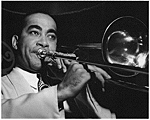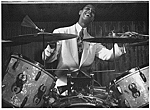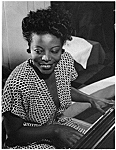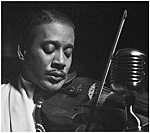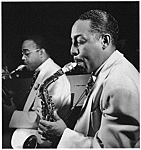Today in History: April 29
Duke Ellington

Portrait of Duke Ellington,
William P. Gottlieb, photographer, New York, New York, circa September 1946.
Golden Age of Jazz
Duke Ellington is seen here reflected in his dressing room mirror in a picture taken by William Gottlieb for an article in the September 23, 1946 issue of Down Beat magazine. The caption read, "…Duke Ellington with his mirror reflecting his always present piano, his conservative ties, his 20 suits, his 15 shirts, his suede shoes and his smiling self." Ellington enjoyed being the sophisticated gentleman and would tell the band,
"Let's not pout, gentlemen. It makes bad notes."
Edward Kennedy "Duke" Ellington, often said to be America's greatest composer, bandleader, and recording artist, was born on April 29, 1899 in Washington, D.C. Titled "Duke" as a youngster, Ellington turned down a visual arts scholarship to focus his life on music. With a background in classical, popular, ragtime, and stride music, Ellington emerged as arguably the greatest single talent in the history of jazz.
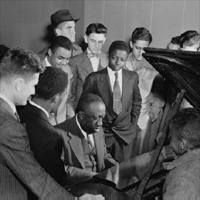
Portrait of James Price Johnson, New York, New York(?),
William P. Gottlieb, photographer, circa May 1946.
Photographs from the Golden Age of Jazz.
Duke Ellington taught himself James P. Johnson's "Carolina Shout" by slowing down a piano roll and copying each note. When Johnson appeared in Washington, pals pushed Duke to play for Johnson and the two became friends. Later in New York both men played Harlem rent parties.
Along with a group of musician friends, Ellington moved to New York where, between 1923 and 1927, they played a wide variety of venues and made some sixty recordings. Their first big break came after Joe "King" Oliver turned down an engagement at the Cotton Club. The gig went instead to the group which was, by then, under Ellington's leadership.
During an era of strict segregation, the Club prided itself on presenting black performers to white audiences. Paradoxically, however, it refused to seat African Americans: making exceptions for only a few famous individuals such as Bill "Bojangles" Robinson or Ethel Waters. Nevertheless, frequent live radio broadcasts from the Cotton Club, where the band played from 1927 through 1931, meant that listeners all across the nation became familiar with the Ellington sound.
Over the next forty-plus years Ellington and the band maintained an astounding schedule, at home and abroad. No venue was too small or too grand, and the band often played two shows a day for weeks running, then added in a recording session. Despite a slump during the late forties and early fifties, from which they rebounded following their appearance at the 1956 Newport Jazz Festival, Ellington and his remarkably stable band performed at this rigorous pace into the early 1970s!
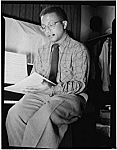
Portrait of Billy Strayhorn, New York, New York,
William P. Gottlieb, photographer, between 1946 and 1948.
Golden Age of Jazz
The collaboration of Ellington and Strayhorn is one of the most important in the history of American music. Gordon Parks said, "They were like Clark Kent and Superman…they didn't talk about the music, one would just leave it for the other one, and he would pick up as if he had been writing the whole thing himself." This practice has made it difficult to distinguish clear authorship in much of the "Ellington" work.
Over the years Ellington worked musically with many people who became his friends and admirers: Florenz Zigfield, Irving Berlin, Jimmy Durante, Al Jolson, Mary Lou Williams, John Coltrane, Will Marion Cook, Lena Horn, Dizzy Gillespie, Ella Fitzgerald, Max Roach, Count Basie, Louis Armstrong, Mahalia Jackson, Charles Mingus, Frank Sinatra, Maurice Chevalier, and Bing Crosby among others. Billy Strayhorn, his closest collaborator, joined the band in 1939 and they composed together constantly until Strayhorn's death in 1967.
Ellington's musical versatility was atstounding and not limited to a traditional jazz format. He also wrote oratorios, suites, concertos, and even opera. He wrote for the Broadway stage, movies, television, night clubs and more. Ellington, frequently working with Strayhorn, created over 1,500 pieces of music — nearly 6,000 if brief musical interludes are included. His shows, performance, and theater pieces include Jump for Joy, "Man with Four Sides," and "My People" (for the Century of Negro Progress Exposition in Chicago). His classical music includes "The Liberian Suite" (commissioned for the centenary of Liberia), background music for Shakespeare's Timon of Athens, and versions of Tchaikovsky’s Nutcracker Suite and Grieg's Peer Gynt Suite.
Ellington also wrote for and performed in a number of films: Black and Tan Fantasy, Cabin in the Sky, and Assault on a Queen. In 1950, Ellington was featured in three film shorts: Salute to Duke Ellington; Symphony in Swing; and Date with Duke, which combined live action and animated puppets performing the Ellington/Strayhorn piece, "Perfume Suite." Ellington and Strayhorn also composed the score for the 1959 film Anatomy of a Murder.
William P. Gottlieb, photographer, New York, New York, circa 1946 to 1948.
Golden Age of Jazz
Ellington, according to Alvin Ailey, "collected around him a group of superbly gifted musicians who were like his Stradivarius." A few are pictured here. Trombonist Lawrence Brown joined the band in 1932 and stayed for nineteen years. Drummer Sonny Greer was with the band from its beginning in Washington, D.C. Willie Smith held a chemistry degree from Fisk and played alto sax with Ellington in the early 1950s. In 1929, Ellington hired trombonist Juan Tizol, who added a Latin influence. Mary Lou Williams, one of the great ladies of jazz, occasionally arranged for Ellington and sat in for him at piano when he was hospitalized. Ray Nance played both the violin and trumpet, earning the nickname "Floorshow" for his performance style. Johnny Hodges, known for his genius on the saxaphone, was with Ellington for nearly forty years. For about five years Al Sears played exciting solos on the tenor sax. There were many others as well, including Paul Gonsalves who was with Ellington for twenty four years and caused a near riot with his twenty-seven chorus solo at the 1956 Newport Jazz Festival.
In his seventies, Ellington continued to tackle new musical challenges. He accepted a commission from the American Ballet Theater to develop The River, a ballet choreographed by Alvin Ailey, as well as a commission from the New York Public Broadcasting station, WNET, to complete a comic opera.
Ellington recieved sixteen honorary doctorates from U.S. universities and numerous citations. His image has been portrayed on postage stamps and medals, and schools, bridges, and babies have been named in his honor. Ellington was knighted, and recieved the French Legion of Honor, the Ethiopian Emperor's Star, the Order of Lenin from the Soviet Union, the Spingarn Medal, and the Presidential Medal of Freedom.
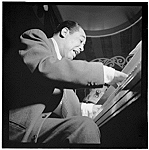
Portrait of Duke Ellington at the Aquarium
William P. Gottlieb, photographer, New York, New York, between 1946 and 1948.
Golden Age of Jazz
The best known of Ellington's later works were his three Sacred Concerts which drew on both classical European and African-American forms and styles. The first was performed in 1965 at Grace Cathedral in San Francisco; the second premiered at the Cathedral of St. John the Divine in New York; and the third in 1973 at Westminster Abbey, London. Asked why it was taking so long to write the last of his concerts Ellington said, "You can jive with secular music, but you can't jive with the Almighty." When Duke Ellington died in 1974 over 12,000 mourners said goodbye to "the piano player," as he called himself; "…our Shakespeare, Goethe, and Cezanne," according to Rob Gibson, the Lincoln Center's Director of Jazz.
Learn more about ragtime and jazz music and musicians through the American Memory collections:
- Photographs from the Golden Age of Jazz consists of over 1,600 photographs of celebrated jazz artists. It documents the jazz scene from 1938 to 1948, primarily in New York City and Washington, D.C. Search on names such as Duke Ellington, Billy Strayhorn, Louis Armstrong, Charlie Parker, Billie Holiday, Dizzy Gillespie, Lena Horne, Stan Kenton, Ella Fitzgerald, or Mel Torme to see these artists at work and play.
- At four-years-old, Edward Ellington listened to his mother play a popular piano tune, "The Rosary," and tears came to his eyes because, "It was so pretty. So pretty." He started to study piano at seven and told his next door neighbor, "One of these days I'm going to be famous."
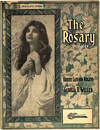
"The Rosary," Georgia B. Welles, composer, 1903.
Historic American Sheet Music, 1850-1920 - Search on terms like rag and jazz in the following collections to see examples of such tunes as they were distributed in sheet music form when Ellington was young. Remember that these primary historical documents reflect the attitudes, perspectives, and beliefs of different times and may contain materials offensive to some readers.
- African-American regiments in World War I were usually accompanied by bands. The most famous was the band of the 369th Infantry, led by James Reese Europe. Such bands introduced many Europeans and American servicemen to jazz and ragtime rhythm and African-American performance styles. Vaudeville star Noble Sissle, who belonged to Europe's band, prepared The Memoirs of "Jim" Europe. It includes information about the racial climate in the U.S. and France and is presented in conjunction with the World War I and the Post-War Society section of the exhibition The African American Odyssey: A Quest for Full Citizenship. In November 1918 The Cleveland Advocate carried a related article, "Colored Yank Soldiers Jazz Their Way Through France," part of the collection African-American Experience in Ohio, 1850-1920.
- Leonard Bernstein discussed the overlap of jazz and symphonic music in his New York Philharmonic Young People's Concert series. Search on the term jazz in the Leonard Bernstein Collection, 1920-1989 to find a transcript of that March 1964 program as well as other related items.
- The Writers' Project of The Works Progress Administration (WPA), provided jobs for unemployed writers during the Depression. Among these writers were Zora Neale Hurston, Nelson Algren, Saul Bellow, Ralph Ellison, Margaret Walker, John Cheever, Richard Wright, and poet May Swenson. Interviews conducted by these and other writers comprise the collection American Life Histories, 1936-1940. Search the collection on the term jazz and read, for example, about Jazz Music (Chicago).
Vassar College
And so you see, to old V.C.
Our love shall never fail.
Full well we know that all we owe
To Matthew Vassar's ale.Verse from once popular Vassar song,
quoted in an online essay about Matthew Vassar, Vassar College Web site.
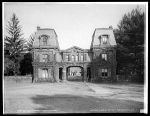
Entrance to Vassar College, Poughkeepsie, New York, copyright 1904.
Touring Turn-of-the-Century America, 1880-1920
Matthew Vassar, founder and namesake of Vassar College, was born on April 29, 1792 in Norfolk, England. Inspired by his niece, Lydia Booth, Vassar donated half of the fortune he had made in the brewing business, as well as 200 acres of land in Poughkeepsie, New York, for the establishment of a women's college comparable to the best educational institutions of the day, most of which excluded women.
Vassar Female College opened in September 1865 with 353 students and a faculty of thirty, twenty-two of whom were women. Courses ranged from botany to music, with an annual fee for tuition and residence of less than $400. By 1873, John H. Raymond, the President of Vassar, was able to write regarding a collegiate education for women,
The idea has ceased to be a strange one to the public mind. No subject has been more frequently or earnestly discussed for the last five years in the newspapers and magazines, and no one can doubt that the drift of the discussion has been toward a favorable verdict.Vassar College. A Sketch of Its Foundation, Aims, and Resources, and of the Development of Its Scheme of Instruction to the Present Time
by John H. Raymond, p. 74
May, 1873.
The Nineteenth Century in Print
Now a coeducational institution, Vassar continues to be ranked among the top liberal arts colleges in the United States.
Vassar graduates include Edna St. Vincent Millay (1917), the first woman to win a Pulitzer Prize for Poetry; Helen C. Putnam (1878), the first woman gynecologist; cardiologist Bernadine Healy (1965), the first woman to head the National Institutes of Health; and Vicki Miles-LaGrange (1974), the first African-American woman sworn in as a United States Attorney.

Vassar College, Poughkeepsie, New York, copyright 1912.
Taking the Long View, 1851-1991
- Search on the names of colleges and universities to find other campus pictures in Touring Turn-of-the-Century America, 1880-1920 and Taking the Long View, 1851-1991, or search the Today in History Archive on college.
- For more material on the history of women's education, see the Today in History features on Elizabeth Blackwell, the first woman to receive a medical degree in the United States, and Mary Church Terrell, educator, political activist, and first president of the National Association of Colored Women.
- Search on the term Vassar in the Books section of The Nineteenth Century in Print to find items such as Vassar College and Its Founder, an 1867 offering by Benson J. Lossing.
- Be sure to see "Women Pioneers in American Memory," a feature presentation of the Learning Page which illustrates women's history with materials from American Memory.
- Edna St. Vincent Millay was called the "voice of her generation." The 1912 publication of her poem "Renascence" while she was a Vassar undergraduate gained her instant recognition. A pencil holograph of the poem's unfinished original draft may be seen in the Imagination section of American Treasures exhibition.
- Search on the term Poughkeepsie in the collection Small-Town America, 1850-1920 to see stereoscopic views of Poughkeepsie, New York, where Vassar is located.
- Like Matthew Vassar, August Anheuser Busch, Jr. was also a brewing magnate. Learn about the famous Anheuser Busch brewing family through Today in History.
